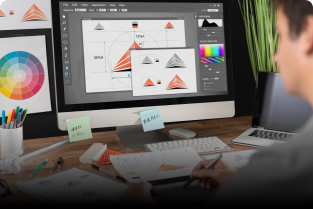Graphic design is a field that blends creativity, technology, and communication. For many aspiring graphic designers, a common question arises: Do you need to be good at drawing to succeed in this profession? The answer isn’t a simple yes or no; it depends on the type of graphic design work you aim to do and your overall approach to the craft. Let’s dive into this topic and explore how drawing skills relate to graphic design.
The Role of Drawing in Graphic Design
Drawing has traditionally been associated with artistic professions, and graphic design is no exception. Historically, designers often relied on hand-drawn sketches to conceptualize ideas. However, with the advent of digital tools, the necessity for manual drawing has diminished in many areas of design.
Drawing skills can be advantageous in certain scenarios:
- Concept Sketching: Being able to quickly sketch ideas helps communicate concepts to clients or team members. These sketches don’t need to be highly detailed; they serve as visual aids to express thoughts.
- Illustration-Based Design: If your design work involves creating custom illustrations, such as for book covers or branding, drawing skills become more critical.
- Creative Exploration: Drawing allows for brainstorming and experimenting with ideas in a way that digital tools might not.
Graphic Design Without Drawing Skills
The reality is that many successful graphic designers don’t rely on traditional drawing skills. Modern graphic design often involves:
- Digital Tools: Software like Adobe Photoshop, Illustrator, Figma, and Canva enable designers to create stunning visuals without needing to draw by hand.
- Typography and Layout: Much of graphic design revolves around arranging text, images, and other elements to convey a message effectively. This aspect doesn’t require drawing skills but does demand a strong sense of composition and visual hierarchy.
- Stock Assets: Designers frequently use stock images, vectors, and pre-made templates to build their designs, reducing the need for custom illustrations.
- Collaboration: In larger projects, designers may work alongside illustrators or other specialists, delegating tasks like drawing when necessary.
Skills That Matter More Than Drawing
While drawing can be a useful skill, other abilities are often more crucial for graphic designers:
- Creativity: The ability to think outside the box and come up with innovative solutions.
- Visual Communication: Understanding how to convey messages through visuals effectively.
- Software Proficiency: Mastery of industry-standard tools.
- Attention to Detail: Ensuring designs are polished and error-free.
- Adaptability: Staying updated with design trends and technologies.
How to Improve as a Designer Without Drawing
If you’re not confident in your drawing abilities, don’t worry. Here are ways to thrive as a graphic designer:
- Learn Design Principles: Focus on mastering color theory, typography, and composition.
- Practice with Digital Tools: Experiment with graphic design software to build your technical skills.
- Use References and Inspiration: Look at other designers’ work for ideas and guidance.
- Take Courses: Enroll in graphic design classes to gain structured learning.
- Collaborate: Work with illustrators or other artists to complement your skills.
Conclusion
While the ability to draw can enhance a graphic designer’s skill set, it is not a strict requirement for success. Modern graphic design emphasizes digital tools, creativity, and communication skills more than traditional drawing abilities. If you have a passion for design and a willingness to learn, you can excel in this field regardless of your drawing expertise. Ultimately, your ability to create compelling and effective designs is what truly matters.

